![]()
![]()
![]()
Use LEFT and RIGHT arrow keys to navigate between flashcards;
Use UP and DOWN arrow keys to flip the card;
H to show hint;
A reads text to speech;
164 Cards in this Set
- Front
- Back
|
Components of a sensory receptor
|
The components of a sensory receptor:
- Cell body (soma, perikaryon) - Transduction site - Axon - Synaptic terminal |
|
|
Receptor Potential
|

- Receptor potentials are generated at the transduction site of a sensory receptor
- Receptor potentials = “graded potentials” or "analog signals" |
|
|
Action Potential
|
- Action potentials are generated in the trigger zone
- Conducted along the distal part of the axon, followed by the proximal part of the axon, until they reach the synaptic terminal |
|
|
Transmitter Release
|
1. Transmitter released into the synaptic cleft
2. Binding to receptors within the postsynaptic membrane of the postsynaptic cell (the second order neuron of the sensory pathway) |
|
|
4 Attributes of a Sensory Stimulus
|
1. Modality - physical type of stimulus - e.g. sound, light
2. Intensity - amplitude of a stimulus 3. Duration - time between start and end 4. Location |
|
|
Labeled line code
|
"Law of specific nerve energies"
|
|
|
Frequency Code
|
- If receptor potentials are above threshold, action potentials are induced
- Higher stimulus intensities induce higher receptor potentials - lead to a generation of higher numbers of action potentials per time unit |
|
|
Population Code
|
High intensity stimuli can activate more individual axons than low intensity stimuli.
|
|
|
Slowly Adapting vs. Rapidly Adapting Receptors
|
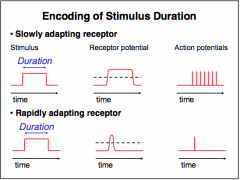
- Slowly adapting receptors remain depolarized and produce increased rates of action potentials for the whole duration of the stimulus = CONSTANT MONITORING
- Rapidly adapting receptors may only signal the onset of the stimulus; receptor potential quickly returns to baseline values and no action potentials are generated after this initial phase = MORE SENSITIVE TO CHANGES |
|
|
Receptive Field
|
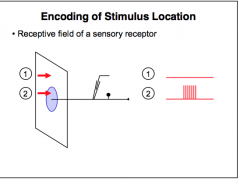
Area where responses can be induced in a certain neuron (either the receptor neuron itself, or any other neuron within a sensory pathway)
|
|
|
Convergence vs. Divergence
|
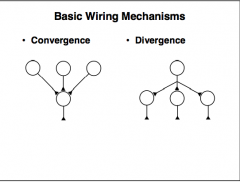
1. Convergence: second order neuron in a sensory pathway receives input from more than one first order neurons
2. Divergence: signal from one first order neuron diverges by sending axon collaterals to > 1 subsequent neuron |
|
|
Lateral Inhibition
|
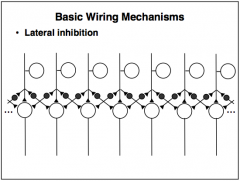
Elements are first order neurons (open circles in the first row of the figure), inhibitory interneurons (filled circles), and second order neurons (open circles in the last row).
|
|
|
Touch Receptors
|
- Merkel’s disks (discriminative touch)
- Ruffini’s endings (skin stretch) |
|
|
Vibration
|
- Meissner’s corpuscles
- Pacinian corpuscles |
|
|
Pain
|
- Pricking pain = rapidly adapting mechano-sensitive or thermo-sensitive receptors
- Burning pain = slowly adapting polymodal receptors |
|
|
Temperature
|
Free nerve endings
|
|
|
Proprioception
|
Muscle spindles and Golgi tendon organs are the main proprioceptors, somatosensory receptors of the musculo-skeletal system.
|
|
|
A la afferent
|
- Primary receptor of a muscle spindle is a rapidly
adapting receptor - Carries sensory information of muscle stretch - Forms the afferent limb of the myotatic reflex |
|
|
Golgi Tendon
|
- Golgi tendon organs are positioned close to the border between muscle and tendon
- Ib afferent fibers form the afferent limb of the reverse myotatic reflex (inverse myotatic reflex) |
|
|
4 Fiber Types
|
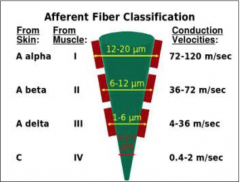
1. Large myelinated fibers
2. Medium myelinated fibers 3. Small myelinated fibers 4. Unmyelinated fibers |
|
|
Spinal Nerves
|
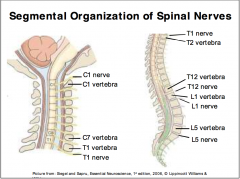
- C1 emerges above the first cervical vertebra and the last cervical nerve (C8) below the last cervical vertebra.
- T1 emerges between the 1st and 2nd thoracic vertebrae - T12 below the last thoracic vertebra. - L1 emerges between the L1 and L2 vertebrae and L5 below the last lumbar vertebra |
|
|
Dermatomes
|
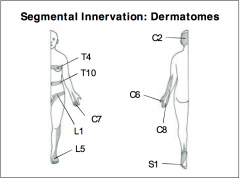
• C2: back of the head
• C6: thumb • C7: middle finger • C8: little finger • T4: nipple line • T10: umbilicus • L1: groin • L5: big toe • S1: little toe |
|
|
Dorsal Column / Medial Lemniscus System
|
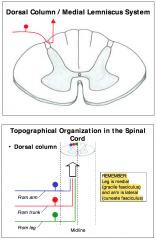
- Fibers of the dorsal root ganglion neurons carrying sensations of touch, vibration and proprioception use the dorsal column / medial lemniscus system.
- They enter the dorsal column of the spinal cord and ascend within this white matter tract up to the medulla, where they synapse in the nuclei of the dorsal columns (cuneate and gracile nucleus). - Upper extremity ascend in the cuneate fasciculus - Lower extremity in the gracile fasciculus |
|
|
Anterolateral System
|
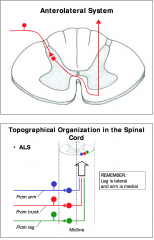
- Fibers of the anterolateral system enter the spinal cord segments also via the dorsal roots of the spinal nerves. - - Central axons of dorsal root ganglion neurons carrying sensations of pain and temperature synapse within the dorsal horn (part of the grey matter) of the spinal cord. - - The axons of the second order neurons cross to the contralateral side through the anterior white commissure and ascend in the ALS fiber tract of the spinal cord (white matter).
Another term used for the anterolateral system fiber tract is spinothalamic tract |
|
|
Lissauer’s Tract
|
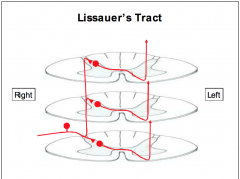
- Collaterals of the primary afferent fibers may ascend (or descend) one or two segments in the dorsolateral fasciculus (or dorsolateral tract, or zone of Lissauer) of the spinal cord
|
|
|
Brown Sequard Syndrome
|
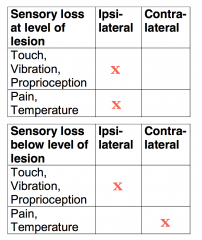
- Hemisection of the spinal cord as a result of a slow- growing mass, or a traumatic lesion
- At the level of the lesion, on the ipsilateral side (side of the lesion), we find loss of sensations for all somatosensory modalities, for touch, vibration and proprioception as well as for pain and temperature. - Below the level of the lesion on the ipsilateral side the sensory loss of touch, vibration and proprioception continues to all dermatomes below. - Below the level of the lesion on the contralateral side (opposite to the side of the lesion), pain and temperature sensations are lost, starting about one or two segments below the lesion, and including all dermatomes further down. |
|
|
Brown Sequard Syndrome & Lissauer's Tract
|

|
|
|
Syringomyelia
|
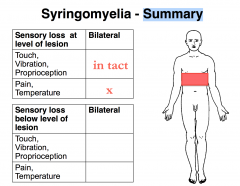
- A pathologic enlargement of the central canal of the spinal cord
- As the cavity expands, it interrupts fibers that cross through the anterior white commissure - Touch and vibration = in tact - Pain and temperature = lost in that region |
|
|
Generalized pathway for touch
|
- 3 neuron chain
Ist order neuron (somatosensory receptor neuron): afferent fibers in peripheral nerve 2nd order neuron: fibers crossing the midline and terminating in the thalamus 3rd order neuron: fibers running in posterior limb of internal capsule and ending in S1 (primary somatosensory cortex) |
|
|
Trigeminal Pathway for Touch
|
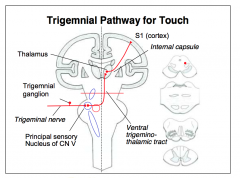
- Primary afferent sensory receptor neurons have their
cell body in the trigeminal ganglion. - The primary afferent fibers carrying touch, vibration or proprioception sensory information enter the brainstem at the pons. - They synapse in the principal (chief) sensory nucleus of CN V in the upper half of the pons. - Fibers of second order neurons exit the principal nucleus of CN V and immediately cross over to the contralateral side, where they ascend in the Ventral trigeminothalamic tract. They synapse in the ventral posterior medial (VPM) nucleus of the thalamus. - Third order neurons in the VPM nucleus of the thalamus send their axons through the posterior limb of the internal capsule, close to the genu, and then through the corona radiata. They synapse in the primary somatosensory cortex (S1). |
|
|
Primary somatosensory Cortex
|
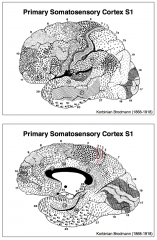
- Primary somatosensory cortex S1 is located in the parietal lobe of the cerebral cortex
- Forms the postcentral gyrus (and part of the paracentral lobule in the medial view). - Brodmann’s areas 3, 1 and 2 |
|
|
Somatotopic Map
|
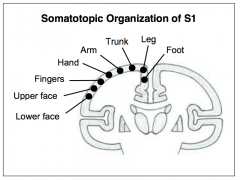
Map refers to points of our body’s surface, the map for the somatosensory system is called a somatotopic map
|
|
|
Columnar Organization
|
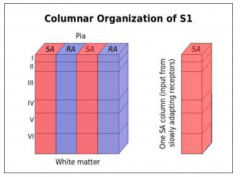
Neurons processing input from (preferentially) slowly
adapting receptors (SA) are located in one column (from the surface of the cerebral cortex close to the pia mater down to the bottom where the white matter begins). The following column contains neurons processing input from rapidly adapting receptors (RA). |
|
|
2-point Discrimination
|

1. High density of cutaneous mechanoreceptors
2. Small receptive fields of the receptors (Merkel's disks and Meissner’s corpuscles) 3. Larger cortical area involved 4. Special mechanisms, such as lateral inhibition, can improve spatial resolution |
|
|
Tabes dorsalis
|
A clinical syndrome which is the consequence of a syphilitic infection. Destruction of dorsal root ganglion cells with large diameter myelinated axons causes severe deficit in touch and proprioception. Nociception and temperature sense remain almost unaffected.
|
|
|
Phantom limb sensations
|
This phenomenon may be explained by a rearrangement of cortical input to the area that formerly represented the hand. Touch pathways originating in the face are likely to form new circuits within the primary somatosensory cortex (S1) that connect them with cortical neurons that would have otherwise become “jobless”
|
|
|
Nociceptive Pain
|
Pain resulting from the activation of nociceptors, which can be activated by stimuli that have the potential to cause tissue damage.
|
|
|
Neuropathic Pain
|
Cannot be explained by a simple activation of nociceptors by tissue damage, and includes any pain syndrome in which the predominating mechanism is a site of aberrant somatosensory processing in the peripheral nervous system (PNS), or central nervous system (CNS).
|
|
|
First Pain vs. Second Pain
|
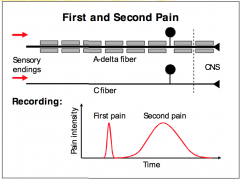
First Pain = sharp, pricking sensation. It results from an activation of thermal or mechanical nociceptors and signal conduction through myelinated A-delta fibers.
Second Pain = burning sensation that has a slower onset. It results from an activation of polymodal nociceptors and signal conduction through unmyelinated C fibers. |
|
|
Referred Pain
|
Neurons in the grey matter of the spinal cord receive convergent inputs from visceral and somatic afferent neurons and send ascending projections into the anterolateral system (ALS)
|
|
|
Pain Pathway
|
3 neuron chain:
- Ist order neurons (somatosensory receptor neuron): afferent fibers in peripheral nerve - 2nd order neurons: fibers crossing the midline and terminating in thalamus - 3rd order neurons: fibers running in posterior limb of internal capsule and ending in S1 (primary somatosensory cortex) |
|
|
The Spinal Nerve Pathway for Pain: Anterolateral System
|
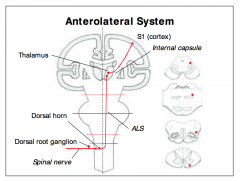
- Primary afferent fibers start in the dermatomes of the skin and synapse in the dorsal horn of the grey matter of the spinal cord, in a region called substantia gelatinosa,
- Fibers of the second order neurons cross over to the contralateral side, where they ascend in the ALS fiber tract up to the ventral posterior lateral nucleus of the thalamus, where they form synapses on third order neurons. - The axons of third order neurons run through the posterior limb of the internal capsule and the corona radiata, and synapse in the primary somatosensory cortex S1 |
|
|
The Trigeminal Pathway for Pain
|
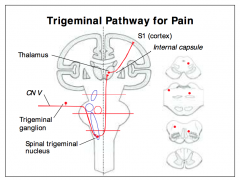
Primary afferent fibers carrying pain and
temperature sensations enter the brainstem at the pons. - Instead of synapsing in the principal (chief) sensory nucleus of CN V, the fibers descend ipsilaterally in the Spinal trigeminal tract, to synapse in the lower third of the spinal nucleus of CN V, located in the lower medulla. - Fibers of second order neurons immediately cross the body’s midline in the lower medulla and then ascend in the ventral trigeminothalamic tract until they reach the ventral posterior medial nucleus of the thalamus. - Axons of the third order neurons ascend through the posterior limb, close to the genu of the internal capsule, run through the corona radiata, and synapse again in the primary somatosensory cortex (S1). |
|
|
Nociceptors Transduce Painful Stimuli
|
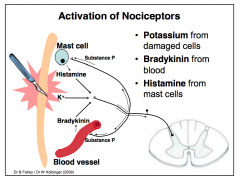
Tissue damage leads to release of a number of chemical substances, which in turn can activate chemosensitive nociceptors.
|
|
|
Hyperalgesia
|

- Enhanced sensitivity and responsivity to stimulation of the area around the damaged tissue
- Chemical substances released within the damaged area. - Prostaglandins and leukotrienes from damaged cells, and even the signaling substance of primary afferent pain fibers, substance P, are some of the substances that sensitize nociceptors |
|
|
Pain Response After Injury
|
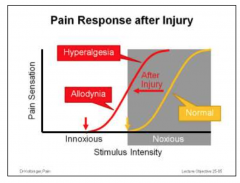
The response curve showing the level of pain sensation in relation to stimulus intensity is shifted to the left. Based on this, previously painless stimuli become painful (allodynia) and the intensity of sensations already painful under normal circumstances is increased (hyperalgesia)
|
|
|
Gate Control in the Spinal Cord
|
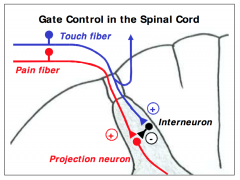
Large myelinated fibers carrying touch sensations activate inhibitory interneurons within the dorsal horn of the spinal cord, which then reduce the flow of nociceptive information through the “gate” between nociceptors + (first order neurons of the pain pathway) and their second order neurons
|
|
|
Gate Control
|
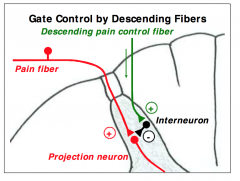
- Descending serotonergic (from periaqueductal grey, nucleus raphe magnus) or noradrenergic (from locus ceruleus) fibers originating in the brainstem participate in the physiological modulation of pain.
- These descending monoaminergic fibers run in the lateral and anterior funiculi of the spinal cord and terminate on the opioidergic interneurons in the dorsal horn, where they control the transmission of pain. |
|
|
Anatomy of the Eye
|

|
|
|
Optic Disk Region
|
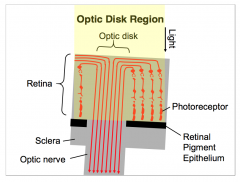
- Light activates the photosensitive elements of the retinal photoreceptors, which are adjacent to the retinal pigment epithelium.
- The optic disc region itself only contains axons of retinal ganglion cells, the output elements of the retina, but it lacks photoreceptors. - BLIND SPOT |
|
|
Ocular Fundus
|
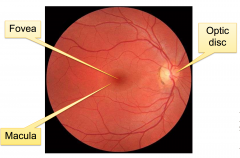
- The back of the eye ball, the ocular fundus, can be examined using an ophthalmoscope.
- The optic nerve head (optic disk) can be easily identified by the radially emerging blood vessels originating in the center of the optic nerve. - The fovea forms the center of the retina and is surrounded by the macula. - Fovea and macula can be identified by the relative absence of large diameter blood vessels. |
|
|
Blind Spot
|
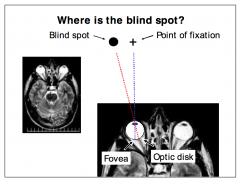
Since the optic disk region does not contain photoreceptor, the visual information of this region is lost
|
|
|
Refractive power
|
- The reciprocal value of the focal distance in meters. Its unit of measurement is called diopter, abbreviated as “D” (plural: diopters).
- Important: cornea is responsible for the main refractive power of the eye of about 42 D, whereas the lens is responsible for the modulation of refractive power (refractive plasticity) during accommodation |
|
|
Accommodation - Far Vision
|
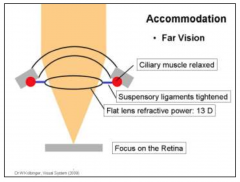
- During far vision, light rays originating from a distant object can be considered (almost) parallel.
- The ciliary muscle, which is a circular muscle around the lens, is relaxed. The diameter of this circular structure is large, causing tightening of the suspensory ligaments (zonule fibers). - Ligaments pull on the lenses’ equator, thereby flattening it and minimizing its refractive power |
|
|
Accommodation - Near Vision
|
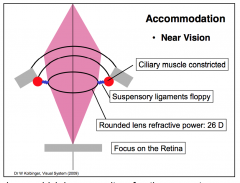
During near vision incoming light rays can no longer be considered parallel. Therefore, a stronger refractive power is needed to focus the light rays on the retina.
- The lens follows its own elasticity and gets a more rounded (more convex) shape, which increases its refractive power to about 26 D in a young individual. |
|
|
Cilary Muscles
|
- Ciliary muscle is activated by parasympathetic fibers of the autonomic nervous system (ANS).
- Cell bodies of the first order efferent parasympathetic neurons are located in the upper midbrain, in the Edinger-Westphal nucleus of cranial nerve III. - Together with the somatic efferent fibers innervating the extraocular muscles, the preganglionic fibers originating in the midbrain form the oculomotor nerve (CN III). - The preganglionic parasympathetic fibers synapse on second order neurons in the ciliary ganglion. - Postganglionic fibers originating in this ganglion form the short ciliary nerves which innervate the ciliary muscle |
|
|
Refractive plasticity
|
The variability of the refractive power of the lens between far vision (13 D) and near vision (26 D)
|
|
|
Presbyopia
|
Lens looses its elasticity during aging - reducing the ability to focus on near objects
|
|
|
Visual acuity
|
Ability to distinguish between two nearby points. Visual acuity is high when the two-point discrimination threshold is low (high spatial resolution).
|
|
|
Dilation of Pupil
|
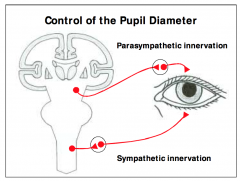
The sympathetic division responsible for pupil dilation.
Preganglionic sympathetic fibers originate in the intermediolateral cell column in the upper thoracic region of the spinal cord. They exit the spinal cord through the anterior (ventral) roots and enter the sympathetic chain, where they ascend to the superior cervical ganglion, where they form synapses on second order neurons. The postganglionic fibers follow the path of the internal carotid artery, the ophthalmic artery and its terminal branches until they reach the iris, where they innervate the radial smooth muscle fibers of the dilator pupilae muscle |
|
|
Constriction of Pupil
|
he parasympathetic division of the ANS is responsible for pupil constriction. Preganglionic parasympathetic fibers originate again in the Edinger-Westphal nucleus of CN III. They synapse in the ciliary ganglion from where the short ciliary nerves originate. These postganglionic parasympathetic fibers innervate the circular smooth muscle fibers of the constrictor pupilae muscle.
|
|
|
Emmetropia
|
Normal sightedness
|
|
|
Myopia
|
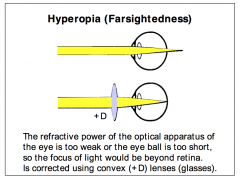
- Focus of objects positioned closer to the eye can be focused on the retina, even without the contribution of the usual mechanisms for near accommodation.
- CONCAVE LENS CORRECTS |
|
|
Hyperopia
|
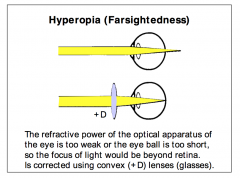
Objects in the far distance from the eye can still be brought into focus, by activating the mechanisms for near accommodation, which increase the refractive power of the eye.
- CONVEX LENS CORRECTS |
|
|
Papilledema
|
The increased pressure compromises the venous drainage of the eye, leading to a dilation of the retinal veins. As a consequence, the optic disc is pushed forward and the disk appears white, rather than pink, as it would under normal conditions.
|
|
|
Detached Retina
|
The retina separates from the retinal pigment epithelium and the areas detached loose their function. A focal lesion in a defined region causes a scotoma. Laser surgery can stop the process of further separation, although the detached part of the retina does not regain its function.
|
|
|
Structure of Photoreceptors
|
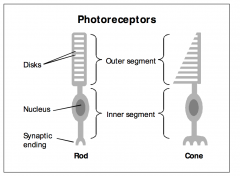
- Outer segments are oriented towards the retinal pigment epithelium (RPE) and their inner segments towards the interior of the eye ball.
- Outer segments contain the visual pigment for the phototransduction process - Inner segments form synapses (rod spherules and cone pedicles) transmitting the visual information on to the subsequent cells of the retina (bipolar cells and horizontal cells). |
|
|
Glutamate
|
The neurotransmitter released at the synaptic endings of retinal photoreceptors is glutamate, which is released in the dark; light reduces the release of glutamate!
|
|
|
Rods
|
- Highly sensitive to light - low intensity light conditions (at night)
- 1 type of rod - Cellular signal amplification mechanisms are well developed. - Unable to distinguish between two subsequent flashes of light (= low temporal resolution) - Convergence is high |
|
|
Cones
|
- Less sensitive to light.
- They work best at higher light intensities, such as bright sunlight. - 3 types of cones (instead of one rod type) enable us to see colors - Signal amplification in cones is lower - Temporal resolution is much better than that of rods - Low convergence - more acuity |
|
|
Disk shedding
|
- New disks are added at the base of the outer segment, while old disks are displaced up the outer segment and are pinched off at the tips
- Discarded discs are phagocytosed by the retinal pigment epithelium (RPE) cells |
|
|
Visual Pigment
|
Rhodopsin = Opsin + Retinal
|
|
|
Opsin
|
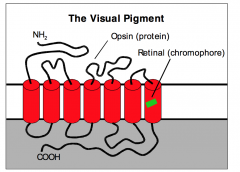
- Protein synthesized in the photoreceptor (cones have different types of opsins).
- The opsin molecule has 7 membrane spanning domains - its amino terminal is located in the disk interior, its carboxy terminal in the cytoplasm of the photoreceptor. |
|
|
Retinal
|
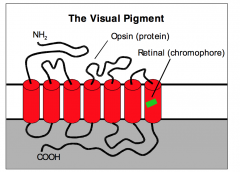
- Chromophore, is the light absorbing compound or the
visual pigment - Derived from Vitamin A - synthesized from beta-carotene - Retinal (indicated as a green rectangle) is COOH covalently attached to one of the amino acids of the 7th membrane spanning region of the protein. |
|
|
Dark Current
|
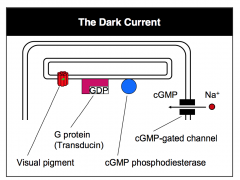
- Photoreceptors, unlike other sensory receptors, are depolarized during darkness
- During darkness, Rhodopsin is coupled to a G protein = inactive state. - In the dark, the G protein does not activate the enzyme cGMP phosphodiesterase. - There is high cGMP (cyclic guanosine 3’5’ monophosphate) available, which keeps the cGMP gated channels in the photoreceptor membrane open -Allows a continuous inward current of sodium ions, which keeps the photoreceptors depolarized in the dark - Release GLUTAMATE while depolarized |
|
|
The Phototransduction Process
|
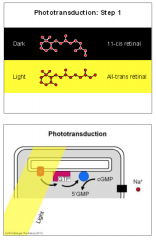
1. Absorption of light causes a conformational change of the retinal molecule from its inactive 11-cis isomer to its active all-trans isomer.
2. cGMP phosphodiesterase is activated via the G protein - causes a breakdown of cytoplasmic second messenger molecule cGMP, metabolizing it to 5’ GMP 3. Reduction of the cGMP concentration in the cytoplasm causes closing of the cGMP gated channels 4. Photoreceptors are hyperpolarized during the light 5. Reduce the release of their neurotransmitter during hyper-polarization |
|
|
Electromagnetic Spectrum
|

The visible part of the spectrum is characterized by wavelengths ranging from 400 to 700 nm (nanometers).
|
|
|
Intensity of light
|
Light intensity is described by the amplitude of the electromagnetic waves.
|
|
|
Types of Cones
|
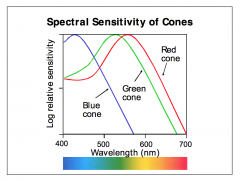
1. S (short wavelength sensitive) cones, also called “blue” cones, with a maximum sensitivity at 430 nm
2. M (medium wavelength sensitive) cones, also called “green” cones, with a maximum sensitivity of 530 nm 3. L (long wavelength sensitive) cones, alsocalled “red” cones, with a maximum sensitivity of 560 nm |
|
|
Color Vision
|
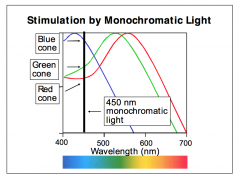
- Light of a wavelength of 450 nm indicated as a black vertical line in the diagram will hyperpolarize blue cones most, green cones to a lesser extent, and red cones even less.
- This pattern of stimulation of the different cone types is responsible for the perception of a specific color, which is some kind of blue (in this example) |
|
|
Key to Color Perception
|
- The key to color perception is a comparison between information from different cone types.
- Perception of the color blue is not based on an exclusive activation of the blue cone - it is the pattern of stimulation, the relative hyperpolarization of the different types of cones determines color perception |
|
|
The Wiring of the Retina
|
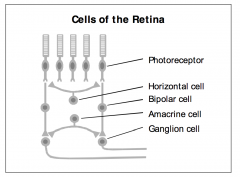
The retina consists of five major cell types.
|
|
|
Retinal Photoreceptors
|
- The retinal photoreceptors (rods and cones) are the input cells of the retina.
- They are depolarized during darkness and hyperpolarized by light, |
|
|
Bipolar Cells
|
- Photoreceptors form synapses on bipolar cells in
the outer plexiform layer of the retina - Bipolar cells transmit their sensory information in the inner plexiform layer on retinal ganglion cells, which are the output cells of the retina. |
|
|
Horizontal Cells
|
Horizontal cells are the crucial elements of the indirect wiring pathway of the retina in the outer plexiform layer. Most of the horizontal cells are inhibitory interneurons involved in the center / surround organization of the receptive fields of bipolar cells.
|
|
|
Amacrine Cells
|
Amacrine cells are the elements of the indirect wiring pathway in the inner plexiform layer
|
|
|
Retinal Output Cells
|
- Retinal ganglion cells connect the retina at a longer distance to the lateral geniculate nucleus (LGN) of the diencephalon.
- Generate action potentials, which are conducted along their axons running in the optic nerves, chiasm and tracts |
|
|
Types of Retinal bipolar cells
|
1. ON bipolar cells - activated (depolarized) when the light is ON
2. OFF bipolar cells - activated (depolarized) during darkness, when the light is OFF |
|
|
On Bipolar Cells
|
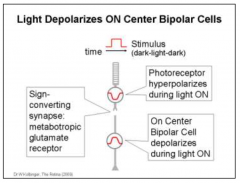
ON bipolar cells are hyperpolarized when the photoreceptors release the maximum amount of glutamate, which is during darkness. They are depolarized (dis-inhibited), when less glutamate is avilable, which is during light ON.
|
|
|
OFF Bipolar Cells
|
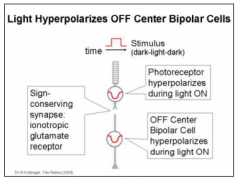
OFF bipolar cells are depolarized when the photoreceptors release the maximum amount of glutamate, which is during darkness.
|
|
|
ON CENTER bipolar cell
|
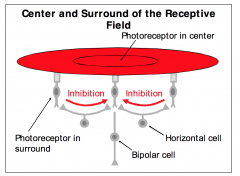
- An ON center bipolar cell is depolarized when you shine light into the center of its receptive field
- When shining light into the surround area of the receptive field of the ON center bipolar cell, photoreceptors in the periphery form excitatory (sign conserving) synapses on adjacent horizontal cells - horizontal cells in turn form inhibitory (sign converting) synapses in the indirect wiring pathway |
|
|
Receptive Fields - ON CENTER bipolar cells
|
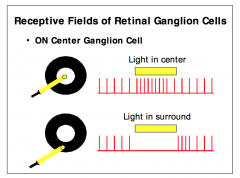
- ON center bipolar cells form excitatory (sign conserving) synapses on ON center ganglion cells
- When shining light into the center of the receptive field of an ON center ganglion cell increases the frequency of action potentials produced - Shining light into the surround of the receptive field of this cell reduces the number of action potentials per time unit |
|
|
Receptive Fields - OFF CENTER bipolar cells
|

- OFF ganglion cells receive input from OFF center bipolar cells via excitatory (sign conserving) synapses.
- Shining light into the periphery of the receptive field of this cell increases the frequency of action potentials produced - Shining light into the center of the receptive field of this cell reduces the number of action potentials |
|
|
Retinitis Pigmentosa
|
- Degenerative disease, in which rods preferentially degenerate
- One of the earliest symptoms is night blindness followed by loss of peripheral vision, leading to “tunnel vision”. - It is a progressive disease which can lead to total blindness - Accumulation of pigment, which can be seen through the ophthalmoscope, gave the disease its name. - Photoreceptor degeneration is often associated with reduced phagocytosis by RPE cells during the process of disk shedding. |
|
|
Nyctalopia
|
- Nightblindness
- Vitamin A deficiency - precursor of retinal (vitamin A aldehyde) which with the opsin protein, forms the photoreceptor pigment |
|
|
Color Blindness
|
2 different types:
1. Protanopia: L cone (“red cone”) absent, 1.3% of males 2. Deuteranopia: M cone (“green cone”) absent, 1.2% of males |
|
|
Hemianopia
|
Visual loss in one half of the visual field (visual hemifield)
|
|
|
Quadrantic anopia
|
Visual loss in one quadrant (1/4) of the visual field
|
|
|
Homonymous anopia
|
Same visual field defect for both eyes
|
|
|
Heteronymous anopia
|
Different visual field defect for both eyes. For example visual loss affecting the temporal visual field in either eye (bitemporal hemianopia) is a heteronymous anopia
|
|
|
The Visual Field
|
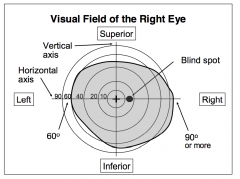
- Above, this person can see objects up to 60
degrees towards the left and up to more than 90 degrees towards the right (RIGHT EYE!) |
|
|
Projections of Visual Field on the Retina
|

- superior half - inferior half
- inferior half - superior half - left - right - right - left - e.g. light from the left superior quadrant - inferior right quadrant |
|
|
More projections
|
- NASAL hemifield - TEMPORAL hemiretina
- TEMPORAL hemifield - NASAL hemiretina |
|
|
Projections of Retinal Ganglion Cells
|
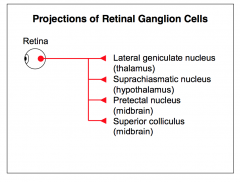
4 Nuclei:
1. Lateral geniculate nucleus (LGN) of the thalamus - the relay station between the retina and the primary visual cortex 2. Suprachiasmatic nucleus of the hypothalamus, where they trigger the circadian clock 3. Pretectal nucleus forming part of the afferent limb of the pupillary light reflex 4. Superior colliculus of the midbrain where they contribute to eye movements. |
|
|
Elements of Visual Pathways
|
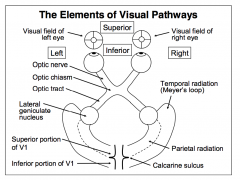
|
|
|
Visual Pathways 1: The Left Superior Quadrant
|
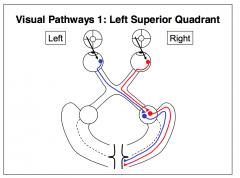
Light originating in the left superior quadrant of the visual field ends up on the retina of the left eye in the inferior portion of the nasal hemiretina.
- Left NASAL fibers cross over - Use the temporal radiation and synapse in the inferior portion (below the calcarine sulcus) of the primary visual cortex (V1). |
|
|
Visual Pathways 2: The Left Inferior Quadrant
|

- Axons originating in the superior nasal quadrant of the retina of the left eye cross over at the optic chiasm, run in the contralateral (right) optic tract and synapse in the right lateral geniculate nucleus (LGN)
- The LGN fibers carry sensory information of the inferior half of the visual field. They follow the parietal radiation pathway and synapse in the superior portion of the primary visual cortex (V1), above the calcarine sulcus - Left NASAL fibers cross over |
|
|
Visual Pathways 3: Right Superior Quadrant
|
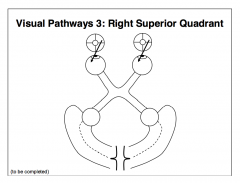
|
|
|
Visual Pathways 4: Right Inferior Quadrant
|

|
|
|
Primary Visual Cortex
|
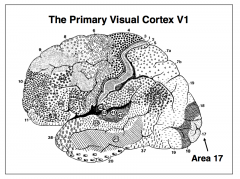
The primary visual cortex (V1) is localized in area 17 of Brodmann’s areas. This area is located in the occipital lobe
|
|
|
Blood Supply to Primary Visual Cortex
|
he primary visual cortex receives its major blood supply from calcarine branches originating from the posterior cerebral artery. Only a small portion of the primary visual cortex located around the occipital pole, may also receive blood supply from the middle cerebral artery (especially after an occlusion of the posterior cerebral artery)
|
|
|
Loss of Blood Supply to Primary Visual Cortex
|
Loss of blood supply through the calcarine branch of the left posterior cerebral artery results in: we would only loss cortex of 1 side (the right) but we would have intact macular vision
- Looking at BLOOD SUPPLY of visual cortex, middle cerebral artery would still be supplying the occipital pole = Homonymous Hemaniopia |
|
|
Retinotopic Organization of V1
|
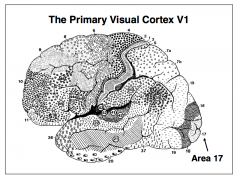
- The left half of the visual field is represented by primary visual cortex on the right
- Inferior portions of the visual field are represented superior to the calcarine sulcus - Superior portions of the visual field inferior to the calcarine sulcus. - The macular region of vision, which is the center of the visual field is represented close to the occipital pole |
|
|
2 types of columns
|
1. Ocular dominance
2. Orientation |
|
|
Ocular Dominance Columns
|

- Columns are dedicated to input from 1 eye - the IPSILATERAL eye (I), which lie next to columns dedicated to input from the CONTRALATERAL eye (C).
- Above shoes IPSILATERAL perference |
|
|
Orientation Columns
|
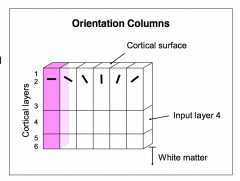
The first column with a horizontal orientation preference, which was described as an example in the section above, is highlighted with a different color.
|
|
|
Depth and Motion Pathway
|
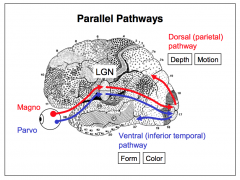
Magno - LGN - Dorsal (parietal) pathway
|
|
|
Form and Color Pathway
|
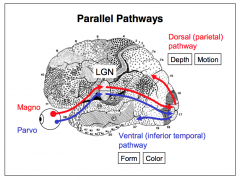
Parvo - LGN - Ventral (interior temporal) pathway
|
|
|
Summary of Lesions
|
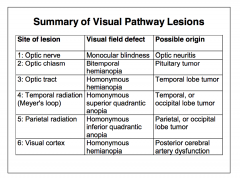
|
|
|
Sparing of the Macula
|
- In cases of visual field deficits, the macula is not deficient = “macular sparing”.
- Macular sparing is often associated with vascular lesions involving the posterior cerebral artery or its branches. - Although posterior cerebral may be blocked, there is sufficient blood flow originating from the middle cerebral artery |
|
|
Types of Eye Movements
|
2 classes:
1. Conjugate: saccadic, vestibulo-ocular reflex, optokinetic reflex 2. Non-conjugate: vergence |
|
|
Saccadic eye movements
|
- Voluntary
- When you look at an oil painting - "jumping" from 1 point of interest to the next |
|
|
Vestibulo-ocular reflex
|
- Keeps your eyes in position of your former point of fixation
|
|
|
Optokinetic reflex
|
- Keeps an object in the center of your visual field as long as possible, by keeping your eyes pointed towards this object
- Fovea is focused on moving target |
|
|
Essential Extraocular Muscles
|

|
|
|
Isolating Extraocular Muscle Function
|
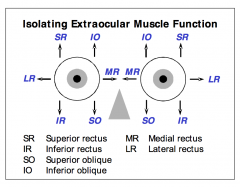
|
|
|
Cranial Nerve Nuclei and Control Units in the Brainstem
|
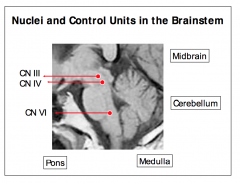
- CN III and IV nuclei are located in the tegmentum of the midbrain, close to the midline and to the cerebral aqueduct. The level of the oculomotor nucleus is approximately in line with the superior colliculus, the trochlear nucleus with the inferior colliculus.
- The nucleus of CN VI is located in the lower pons, close to the ponto-medullary junction. |
|
|
Midbrain
|
Contains the rostral interstitial nucleus of the medial longitudinal fasciculus (MLF), which participates in the control of vertical eye movements, and the superior colliculus
|
|
|
Pons
|
The pontine paramedian reticular formation (PPRF) participates in saccadic eye movements and lateral gaze - also known as the horizontal gaze center.
|
|
|
Cortical Control Units
|
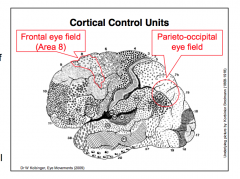
|
|
|
Frontal Eye Field
|
- Located in area 8 of the frontal lobe
- Role in the planning and initiation of eye movements - control of voluntary eye movements, in particular saccadic eye movements. |
|
|
Parieto-occipital Eye Field
|
- The parieto-occipital eye field is located in the area of the junction of the parietal lobe and the occipital lobe
- Involved in eye movements related to motion of the whole visual surround (optokinetic movements), or movements following a moving target (smooth pursuit). |
|
|
Saccadic Eye Movements
|
- Extremely fast eye movements that shift the fovea rapidly to visual targets
- Used to explore the visual environment - Speed up to 900° per second, that visual feedback is completely shut down during these movements - Followed by fixations - Exploring the visual environment: involves both fixations and saccadic eye movements |
|
|
Saccadic Eye Movements Pathway
|
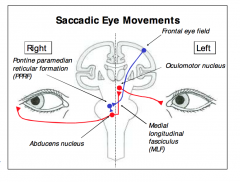
- Descending fibers originating in the frontal eye field cross the body’s midline in the pons
- Synapse on neurons in the pontine paramedian reticular formation (PPRF) on the contralateral side. - Cells in the PPRF activate the adjacent abducens nucleus - The output from the abducens nucleus = 1. innervate the lateral rectus muscle and 2. Cross body’s midline and ascend in the contralateral medial longitudinal fasciculus (MLF) until they reach the oculomotor nucleus. |
|
|
Trochlear Nerve Palsy
|
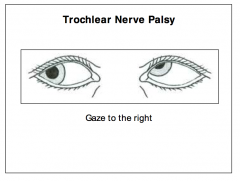
- Lesion of CN IV causes deficit of the superior oblique muscle.
- This leaves the inferior oblique muscle unopposed at medial gaze - Depression at medial and downward gaze is limited and does not exceed the midline. |
|
|
Oculomotor Nerve Palsy
|
- Lesion of the oculomotor nerve (CN III) = the eye is deviated down (and out) due to unopposed action of lateral rectus muscle (CN VI) and superior oblique muscle (CN IV);
- Usually associated with ptosis (drooping of the upper eye lid) and mydriasis (dilation of the pupil). |
|
|
Abducens Nerve Palsy
|
- CN VI is lesioned, the eye is deviated medially due to unopposed action of the medial rectus muscle
|
|
|
Diplopia
|
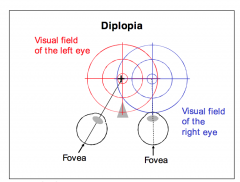
- When both pictures are merged in visual processing areas in the cerebral cortex, the plus sign appears twice on the calculated picture, once in the center, based on the picture produced by the left eye, and a second time towards the left of the center, based on the picture produced by the right eye
|
|
|
The Red Glass Test
|
- The patient holds a transparent piece of red glass over the right eye (right and red) and is then asked to follow a small white flashlight (pen light), which the examiner moves to the six different positions of gaze, similar to the H-test described above
- To ascertain deviations between centers of the visual fields of vision |
|
|
Internuclear Ophthalmoplegia
|
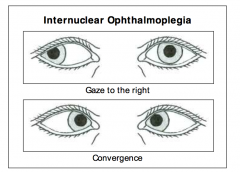
Internuclear ophthalmoplegia is based on a lesion of the medial longitudinal fasciculus (MLF), which prevents adduction of the eye on the side of the lesion during attempted lateral gaze.
|
|
|
PPRF Lesion
|
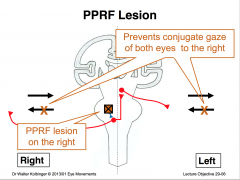
Lesions of the pontine gaze center (PPRF) result in a paralysis of ipsilateral horizontal eye movements. Conjugate horizontal gaze towards the side of the lesion is interrupted. When the left PPRF is damaged, for example, horizontal eye movements of both eyes towards the left are impaired (left gaze palsy). Vertical gaze can still be intact.
|
|
|
One-and-a-half Syndrome
|
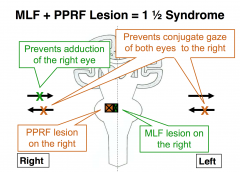
A combination of gaze paralysis in one direction (counts for the “one”) and internuclear ophthalmoplegia in the other direction (counts for the “half”, since one eye is still able to move, but not the other one). Abduction is intact only in one eye.
It is caused by an extensive paramedian pontine lesion involving the PPRF and the MLF on one side of the brainstem. |
|
|
Hair Cells
|
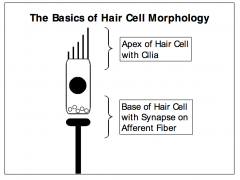
- Apex of a hair cell is the signal transduction site
which contains cilia (stereocilia) - Area is surrounded by endolymph, which has HIGH concentration of potassium ions, compared to the usual extracellular fluid (or the perilymph of the inner ear) - Base of a hair has synaptic terminal, with vesicles containing excitatory transmitter - Synaptic transmission between hair cells stimulates the afferent fibers of the vestibular and cochlear portions of the vestibulo-cochlear nerve (CN VIII) |
|
|
Ionic composition of perilymph and endolymph
|

|
|
|
Depolarization of the Hair Cells
|
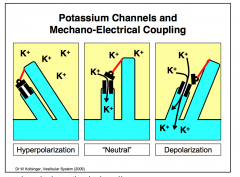
- Opening or closing of mechanically gated cation channels (TRPA1 channels) causes graded potential changes in hair cells, which range from depolarization to hyperpolarization
- Mechanical force produced by a “tip link” between neighboring stereocilia directly opens the cation channels during deflection of the cilia towards the tallest cilium - Inward current of potassium ions depolarizes the hair cells. |
|
|
Depolarization of Hair Cells increases Intracellular Calcium and induces Transmitter Release
|
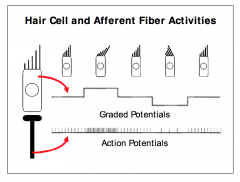
- Voltage-gated calcium channels embedded in the hair cell membrane are opened during depolarization, resulting in an inward current of calcium ions
- Release excitatory transmitter substance at the base of the hair cells, activating the afferent fibers - Action potentials are generated in the afferent fibers |
|
|
Receptor Organs of the Vestibular System
|
2 types of sensory organs = otolith Organs and semicircular Canals
|
|
|
Otolith Organs
|
- Saccule and the utricle are endolymph filled pockets that contain in their walls a patch of sensory hair cells
- Their cilia support calcium carbonate crystals glued together with a jelly like material (otolithic membrane) - When the cilia of the sensory hair cells are tilted, either by gravity forces, or by linear acceleration, the cilia bend, which leads to depolarization or hyperpolarization of the hair cells |
|
|
Semicircular Canals
|
-Endolymph filled pipes which contain a patch of sensory hair cells (crista), with their cilia inserted into a jelly like structure (cupula)
- When the endolymph moves relative to the walls of the canals, induced by angular acceleration (rotation) of the head around one of the axes of the semicircular canals, the cupula with the inserted cilia bends - leads to depolarization or hyperpolarization of the hair cells |
|
|
Otolith Organs in Neutral Position
|
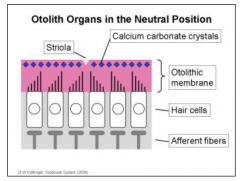
- Utricle and the saccule, detect linear acceleration
- Striola = center |
|
|
Otolith Organs Detecting Linear Acceleration
|
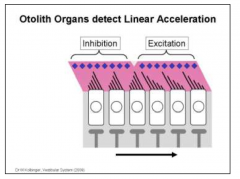
- The stimulus is a linear acceleration towards the right
- On LEFT HALF: due to the inertia of the calcium carbonate crystals, the cilia of the hair cells are tilted AWAY from the kinocilium = INHIBITION - On RIGHT HALF: the hair cells are tilted TOWARDS the kinocilium = EXCITATION |
|
|
Semicircular Canals
|

- The head containing the 3 sets of semicircular canals can rotate around different axes
- The semicircular canals respond to changes in the velocity of the rotations (angular acceleration) |
|
|
Semicircular Canals Detect Angular Acceleration
|
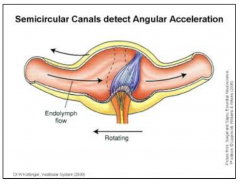
- Endolymph flow, which occurs relative to the semicircular canal, produces pressure onto the cupula and causes it to bend
- This also bends the cilia of the hair cells embedded in the cupula, |
|
|
Vestibular Pathways
|
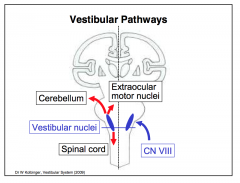
The input pathways include the vestibular receptor organs (with the hair cells as sensory receptor cells), the vestibular ganglia and the vestibular portion of the vestibulo-cochlear nerve (CN VIII).
|
|
|
The Vestibulo-Ocular Reflex (VOR)
|
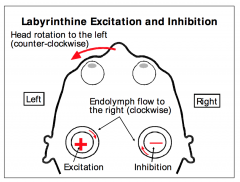
1. Excitation / Inhibition of labyrinthine receptor organs, the horizontal semicircular canals
2. Head rotation to the left (counter-clockwise) induces endolymph flows to the right (clockwise) inside both horizontal semicircular canals 3. Endolymph movement pushes the cupula in the left horizontal semicircular canal towards the back of the head, and the cupula in the right horizontal semicircular canal towards the front (anterior part) of the head 4. Cilia of the hair cells in the left horizontal semicircular canal are bent towards the back of the head, towards the kinocilium = excited 5. Cilia of hair cells in the right horizontal semicircular bent towards the anterior of the head, away from the kinocilium = inhibited OVERALL = Rotation of the head to the left causes excitation of the left labyrinth and inhibition of the right labyrinth |
|
|
The Excited Labyrinth Induces Vestibulo-Ocular Reflex Movements of the Eyes
|
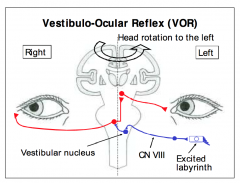
- Semicircular canals relay the information of head rotation to the vestibular nuclei in the brainstem
- Fibers originating in the excited labyrinth form the afferent limb of the VOR enter the brainstem at the ponto-medullary junction - Synapse in the vestibular nucleus - Axons of neurons located in the vestibular nucleus cross the body’s midline and synapse in the contralateral Abducens nucleus - Abducens nucleus activates LR muscle of the right eye - Via fibers crossing the body’s midline end ascending in the medial longitudinal fasciculus (MLF) the oculomotor nucleus - CN III activates the medial rectus muscle of the left eye - LR abducts the right eye and medial rectus muscle adducts the left eye - both eyes turn towards the right |
|
|
Overall Reflex
|
Rotation of head to the left causes an excitation of the left labyrinth. The labyrinthine input to the vestibular nucleus activates the contralateral abducens nucleus, which induces conjugate horizontal eye movements to the right
- THINK: when LEFT labyrinth is ACTIVE - VOR drives the eyes to RIGHT |
|
|
Nystagmus
|
- Rhythmically alternating movements of the eyes
- Most commonly has 2 phases: 1. Slow phase into one direction; 2. Fast phase in the opposite direction. - Slow phase is driven by a reflex circuitry - Fast phase is a simple reset mechanism, driven by the saccadic circuitry |
|
|
The Vestibulo-Ocular Nystagmus
|
- Physiological nystagmus is based on the vestibulo-ocular reflex which resets the eye positions during head rotation
- The slow phase of the nystagmus is in the opposite direction of the head movement, and is driven by the vestibulo-ocular reflex - The fast phase (reset) of the nystagmus is in the direction of the head movement, and is driven by a saccade. |
|
|
Oculocephalic Maneuver (Dolls eyes maneuver)
|
This examination procedure of a passive (passive for the patient, not for the examiner) head movement maneuver can be applied to comatose patients. It is used to determine, whether the vestibulo-ocular reflex pathway from the medulla to the midbrain is intact. The examiner turns the head of the patient in the horizontal (or vertical) plane and notes whether the ocular excursions in the opposite directions occur.
|
|
|
Caloric Testing of the Vestibulo-Ocular Reflex
|
- Procedure the outer ear canal of a patient is irrigated with cold (or warm) water and the examiner observes for conjugate deviation of the eyes, driven by the vestibulo-ocular reflex
- It is a convenient means of testing vestibular function, but is reserved again for comatose patients - A number of board exam review books give you the mnemonic “COWS”, which stands for “Cold - Opposite, Warm - Same” |
|
|
Meniere’s Disease
|
Abnormalities of endolymph circulation can lead to significant dilation of endolymph compartments and degeneration of hair cells. The disease affects the vestibular and the auditory system and is characterized by recurrent sudden attacks of vertigo, tinnitus and sensorineural hearing loss.
|
|
|
Motion Sickness (Kinetosis)
|
Motion sickness occurs when susceptible individuals experience a discrepancy between vestibular and visual inputs. The symptoms are similar to those produced by any of the diseases that affect the vestibular apparatus: dizziness, vomiting and sweating. These usually subside over time.
|
|
|
Alcohol Intoxication
|
Acute alcohol intoxication can also produce vestibular symptoms, such as vertigo. These are usually manifest when lying down (the “spinning bed phenomenon”). It is caused by the interactions of blood alcohol with the endolymph, which can cause convection endolymph flows within the semicircular canals
|

